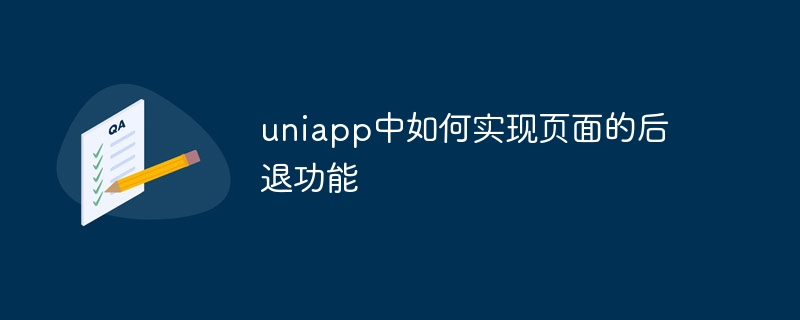How to implement the page back function in uniapp

Uniapp is a front-end framework for developing multi-platform applications. It is based on Vue.js and can compile the developed code into small programs, apps, H5 and other types of applications. Platform applications. In Uniapp, it is very simple to implement the page back function. This article will introduce how to implement the page back function in Uniapp and provide corresponding code examples.
To implement the back function of the page, we need to use the built-in methods and components provided by uni-app to operate. The specific steps are as follows:
- In the page file of uni-app, the
uni.navigateBack()method needs to be introduced. This method is used to return to the previous page.
<template>
<view>
<!-- 页面内容 -->
</view>
</template>
<script>
export default {
methods: {
navigateBack() {
uni.navigateBack()
}
}
}
</script>- When you need to trigger the back function, such as when clicking a button, you can call the
navigateBack()method to realize the page back.
<template>
<view>
<button @click="navigateBack">返回</button>
</view>
</template>
<script>
export default {
methods: {
navigateBack() {
uni.navigateBack()
}
}
}
</script>In the above code, we call the navigateBack() method in the button click event to realize the page back.
In addition to using the uni.navigateBack() method to implement the page's retreat, Uniapp also provides some other methods and components to control the page's retreat behavior.
-
uni.navigateBack(): Return to the previous page, equivalent to the browser's back function. - `uni.navigateBack({
delta: 2
}): Return to the previous two pages, you can set the value ofdelta` as needed. -
<navigator open-type="navigateBack">Return</navigator>: Use the<navigator></navigator>component to implement a back button-like function.
To summarize, it is very simple to implement the back function of the page in Uniapp. We only need to use the uni.navigateBack() method and the corresponding trigger event to achieve it. Of course, we can also choose to use the <navigator></navigator> component to implement the back button function. No matter which method is used, it is easy to rewind the page. I hope the code examples provided in this article can help you implement the page back function in Uniapp.
The above is the detailed content of How to implement the page back function in uniapp. For more information, please follow other related articles on the PHP Chinese website!

Hot AI Tools

Undresser.AI Undress
AI-powered app for creating realistic nude photos

AI Clothes Remover
Online AI tool for removing clothes from photos.

Undress AI Tool
Undress images for free

Clothoff.io
AI clothes remover

AI Hentai Generator
Generate AI Hentai for free.

Hot Article

Hot Tools

Notepad++7.3.1
Easy-to-use and free code editor

SublimeText3 Chinese version
Chinese version, very easy to use

Zend Studio 13.0.1
Powerful PHP integrated development environment

Dreamweaver CS6
Visual web development tools

SublimeText3 Mac version
God-level code editing software (SublimeText3)

Hot Topics
 How do I handle local storage in uni-app?
Mar 11, 2025 pm 07:12 PM
How do I handle local storage in uni-app?
Mar 11, 2025 pm 07:12 PM
This article details uni-app's local storage APIs (uni.setStorageSync(), uni.getStorageSync(), and their async counterparts), emphasizing best practices like using descriptive keys, limiting data size, and handling JSON parsing. It stresses that lo
 How to rename UniApp download files
Mar 04, 2025 pm 03:43 PM
How to rename UniApp download files
Mar 04, 2025 pm 03:43 PM
This article details workarounds for renaming downloaded files in UniApp, lacking direct API support. Android/iOS require native plugins for post-download renaming, while H5 solutions are limited to suggesting filenames. The process involves tempor
 How to handle file encoding with UniApp download
Mar 04, 2025 pm 03:32 PM
How to handle file encoding with UniApp download
Mar 04, 2025 pm 03:32 PM
This article addresses file encoding issues in UniApp downloads. It emphasizes the importance of server-side Content-Type headers and using JavaScript's TextDecoder for client-side decoding based on these headers. Solutions for common encoding prob
 How do I make API requests and handle data in uni-app?
Mar 11, 2025 pm 07:09 PM
How do I make API requests and handle data in uni-app?
Mar 11, 2025 pm 07:09 PM
This article details making and securing API requests within uni-app using uni.request or Axios. It covers handling JSON responses, best security practices (HTTPS, authentication, input validation), troubleshooting failures (network issues, CORS, s
 How do I use uni-app's geolocation APIs?
Mar 11, 2025 pm 07:14 PM
How do I use uni-app's geolocation APIs?
Mar 11, 2025 pm 07:14 PM
This article details uni-app's geolocation APIs, focusing on uni.getLocation(). It addresses common pitfalls like incorrect coordinate systems (gcj02 vs. wgs84) and permission issues. Improving location accuracy via averaging readings and handling
 How do I manage state in uni-app using Vuex or Pinia?
Mar 11, 2025 pm 07:08 PM
How do I manage state in uni-app using Vuex or Pinia?
Mar 11, 2025 pm 07:08 PM
This article compares Vuex and Pinia for state management in uni-app. It details their features, implementation, and best practices, highlighting Pinia's simplicity versus Vuex's structure. The choice depends on project complexity, with Pinia suita
 How do I use uni-app's social sharing APIs?
Mar 13, 2025 pm 06:30 PM
How do I use uni-app's social sharing APIs?
Mar 13, 2025 pm 06:30 PM
The article details how to integrate social sharing into uni-app projects using uni.share API, covering setup, configuration, and testing across platforms like WeChat and Weibo.
 How do I use uni-app's easycom feature for automatic component registration?
Mar 11, 2025 pm 07:11 PM
How do I use uni-app's easycom feature for automatic component registration?
Mar 11, 2025 pm 07:11 PM
This article explains uni-app's easycom feature, automating component registration. It details configuration, including autoscan and custom component mapping, highlighting benefits like reduced boilerplate, improved speed, and enhanced readability.






